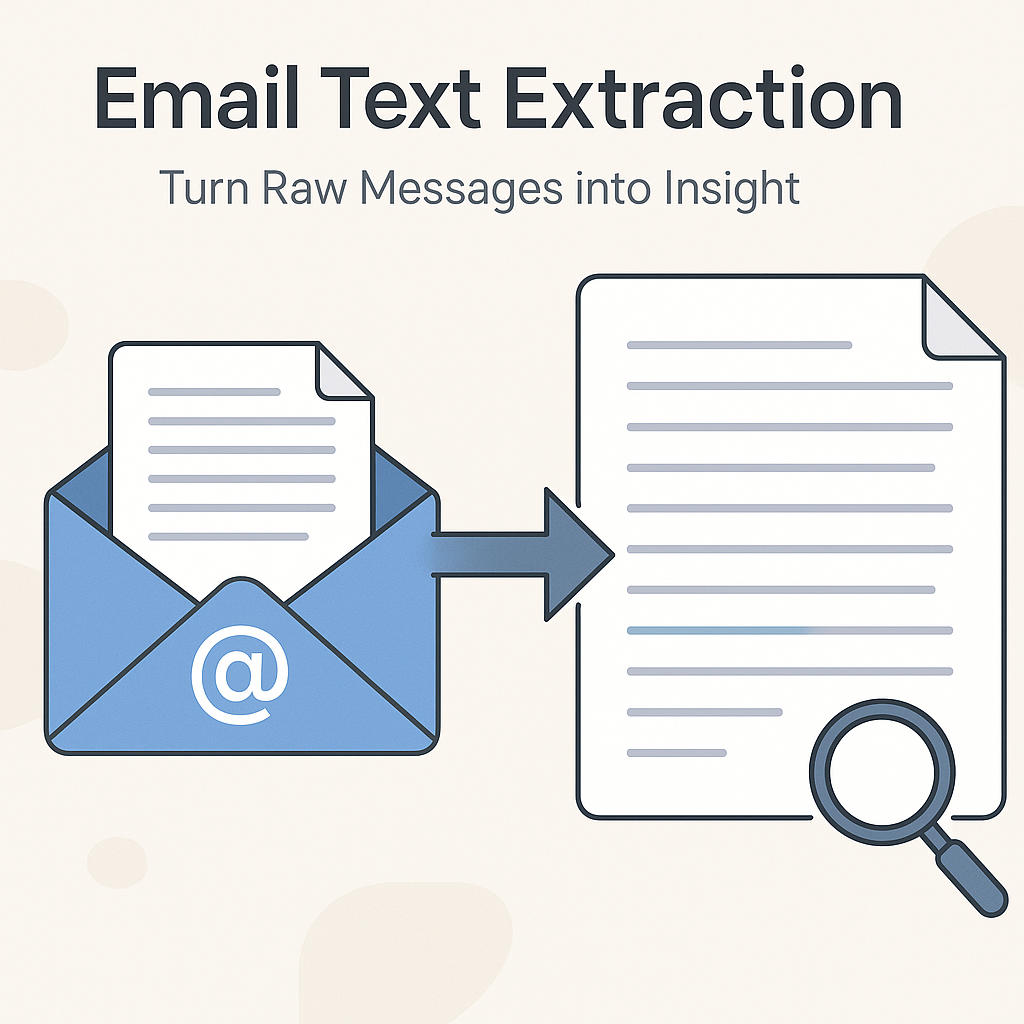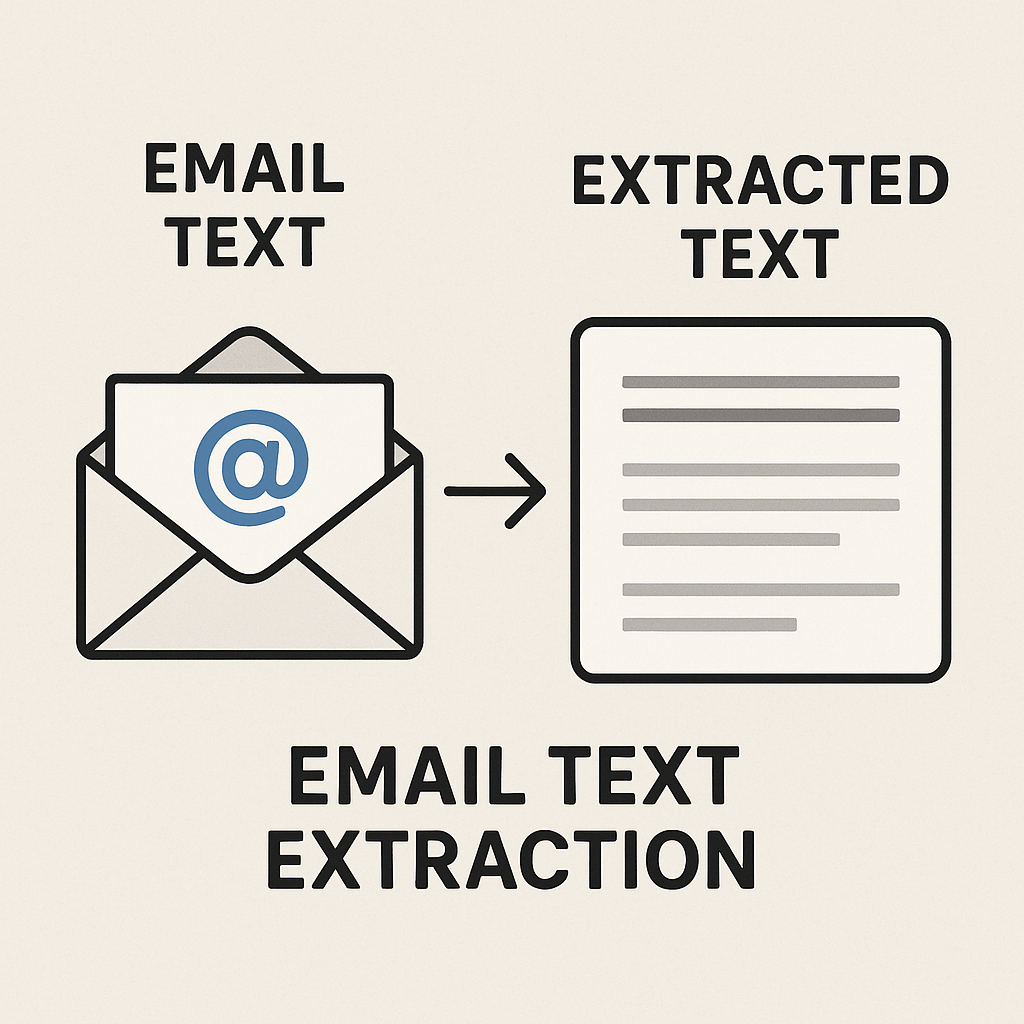Email Text Extraction: Turn Raw Messages into Insight

The modern professional's inbox is a battlefield. Billions of emails are sent daily, each carrying potential value but often buried under a mountain of unstructured text. For executives, entrepreneurs, and sales professionals, sifting through this digital deluge to find critical information – contact details, customer queries, meeting requests, action items – is a constant drain on time and resources. This overwhelming volume isn't just an annoyance; it's a significant bottleneck to productivity and strategic decision-making. The challenge lies in transforming this chaotic stream of raw messages into organized, actionable data. This is where email text extraction becomes indispensable.
What is Email Text Extraction and Why It Matters
Email text extraction is the process of automatically identifying and retrieving specific pieces of information from the body, subject line, or even attachments of emails. Think of it as a digital detective that scans through your messages, finds the data you need, and pulls it out in a structured format. As explained by Saleshandy, an Email Extractor is a tool or software that automatically finds and collects email addresses from various sources, though modern tools go much further in extracting diverse data types.
Emails, by their nature, are often filled with unstructured data. Unlike a neatly organized spreadsheet, the content of an email can vary wildly in format, tone, and detail. Names might be at the beginning or end, phone numbers can be written in different ways, and action items might be embedded within paragraphs of conversational text. This makes manual email data processing incredibly inefficient and prone to errors. The significance of extracting email information lies in its ability to transform this unstructured chaos into structured, actionable insights. By automating the extraction of key data points, businesses can unlock a wealth of valuable information that would otherwise remain hidden, inaccessible, or require arduous manual effort to uncover. This capability is fundamental to enhancing business email analysis and driving operational efficiency.
Key Information to Extract from Emails
The range of information that can be extracted from emails is vast and depends entirely on your business needs. However, some common, high-value data points that professionals frequently seek include:
- Contact Information: Names, email addresses, phone numbers, and physical addresses are vital for sales prospecting, customer relationship management, and general outreach.
- Company Details: Extracting company names, job titles, and industry affiliations helps in segmenting leads and understanding client profiles.
- Dates and Times: Crucial for appointment scheduling, setting deadlines, confirming event dates, and managing calendars effectively.
- Order and Transaction Details: Information like order numbers, product names, quantities, prices, and payment statuses is essential for finance and operations teams.
- Customer Feedback and Sentiment: Identifying customer satisfaction levels, common complaints, praise, or suggestions provides invaluable insights for product development and service improvement.
- Action Items and Tasks: Specific requests, assigned tasks, and deadlines mentioned within email threads are critical for project management and accountability.
- Meeting Requests: Details such as proposed times, attendees, and agendas can be automatically parsed to simplify scheduling.
- Shipping and Delivery Information: Tracking numbers, delivery addresses, and expected delivery dates are important for logistics and customer communication.
The ability to systematically pull out these details means that critical operational and customer data is no longer lost in the inbox. This structured data can then be fed into CRM systems, project management tools, databases, or analytics platforms, making it readily available for further processing and insights. The precise nature of extracting email information can be tailored to specific business requirements, making it a highly adaptable solution.
Manual vs. AI-Powered Email Text Extraction
The way we handle data extraction from emails has evolved dramatically, moving from laborious manual processes to highly efficient AI-driven solutions.
The Manual Grind
Historically, extracting information from emails meant manual labor. A team member would read each email, identify the relevant data points, and then painstakingly copy and paste them into a spreadsheet, CRM, or database. While this method offers direct human oversight for very specific, low-volume tasks, its drawbacks are significant:
- Time-Consuming: This process is incredibly slow, consuming valuable hours that could be spent on strategic tasks like client engagement or business development.
- Error-Prone: Humans are susceptible to fatigue, distraction, and simple mistakes. A misplaced digit in a phone number or an incorrect date can have significant repercussions, leading to costly errors.
- Not Scalable: As email volume increases, manual extraction simply cannot keep pace without a proportional increase in staff, leading to escalating costs and operational inefficiencies.
- Tedious and Demotivating: Repetitive data entry tasks often lead to low morale and high employee turnover, impacting overall team productivity and job satisfaction.
The AI Advantage
AI in email management has revolutionized this process through automated data extraction. AI-powered tools leverage sophisticated algorithms to understand the context and structure of email content, identifying and extracting data with remarkable speed and accuracy. This shift offers substantial advantages:
- Speed and Efficiency: AI can process thousands of emails in minutes, a task that would take humans days or weeks. This dramatically boosts the effectiveness of email productivity tools.
- Accuracy and Consistency: AI models, once trained, perform extraction tasks with high accuracy and consistency, minimizing human error and ensuring data integrity.
- Scalability: AI solutions can easily scale to handle fluctuating or growing email volumes without a linear increase in cost or resources, supporting business growth.
- Cost-Effectiveness: While there's an initial investment in AI tools, the long-term savings in labor, reduced errors, and increased productivity are substantial.
- Frees Up Human Capital: By automating mundane tasks, AI allows employees to focus on higher-value activities like complex problem-solving, strategic planning, and building customer relationships.
The move from manual to AI-powered email data processing is not just an upgrade; it's a fundamental transformation in how businesses interact with their communication data, unlocking new levels of efficiency and insight.
How AI Extracts Text: Understanding the Technology
At its core, AI in email management for text extraction relies on advanced technologies, primarily Natural Language Processing (NLP) and Machine Learning (ML). These sophisticated techniques enable computers to understand and process human language in ways that were once considered science fiction.
- Natural Language Processing (NLP): This is the branch of AI that enables computers to understand, interpret, and manipulate human language. NLP techniques allow AI systems to go beyond simple keyword matching. They can understand grammar, syntax, context, and even nuances like sentiment. For email text extraction, NLP is crucial for deciphering the meaning within sentences and paragraphs. As highlighted by Nylas, automating email parsing can quickly and accurately extract text and metadata from emails for deeper analysis, saving time and reducing manual errors.
- Machine Learning (ML): ML algorithms enable systems to learn from data without being explicitly programmed. In the context of email extraction, ML models are trained on vast datasets of emails and their corresponding extracted information. Through this training, the models learn to identify patterns, recognize specific data formats (like phone numbers or dates), and understand context to accurately pull out relevant entities.
- Named Entity Recognition (NER): A key NLP sub-task, NER is specifically designed to locate and classify named entities in text into pre-defined categories such as person names, organizations, locations, medical codes, time expressions, quantities, monetary values, percentages, and more. For extracting email information, NER is vital for pinpointing names, company affiliations, dates, and addresses within an email's text.
- Pattern Matching and Regular Expressions (Regex): While AI, especially NLP, is more sophisticated, traditional pattern matching using regular expressions can still be effective for highly structured data within emails, like specific ID formats or consistently formatted dates. AI tools often combine these robust pattern-matching capabilities with deeper contextual understanding. This process is essential for managing contact lists efficiently; as Five.co notes, with the right tools, you can transform disorganized text into structured, actionable data.
The Process: An AI system, when tasked with email text extraction, will typically:
- Ingest Email Data: Access and read the content of emails from your inbox.
- Pre-process Text: Clean the text by removing irrelevant characters, standardizing formats, and tokenizing (breaking text into words or phrases).
- Apply NLP/ML Models: Use trained models to identify and classify entities (NER), understand relationships between words, and detect patterns.
- Extract and Structure: Pull out the identified data points and organize them into a structured format (e.g., JSON, CSV, database fields).
This intelligent approach allows for automated data extraction that is both comprehensive and precise, moving far beyond simple keyword searches. Tools focused on business email analysis leverage these capabilities to derive meaningful insights.
Benefits of AI-Driven Email Text Extraction for Productivity
The impact of implementing AI for email text extraction reverberates across an entire organization, leading to significant boosts in productivity and overall business performance.
- Unprecedented Efficiency and Time Savings: The most immediate benefit is the drastic reduction in time spent on manual data entry and sorting. Automating the extraction of information frees up employees from tedious tasks, allowing them to focus on core responsibilities, strategic initiatives, and customer engagement. This is a cornerstone of effective email productivity tools.
- Enhanced Accuracy and Reduced Errors: Human error is a significant factor in data processing. AI systems, when properly configured, perform extraction tasks with a high degree of accuracy and consistency. This means fewer mistakes in contact details, order information, or meeting schedules, leading to more reliable data and fewer costly rework cycles.
- Deeper Inbox Insights: By systematically extracting and organizing data, businesses gain access to a richer understanding of their communications. This allows for more effective business email analysis, uncovering trends in customer inquiries, sales opportunities, or operational bottlenecks. These inbox insights are invaluable for strategic planning and decision-making.
- Streamlined Sales and Lead Management: Sales teams can leverage email text extraction to automatically capture lead information, identify prospect interest, and populate their CRM systems. This accelerates the sales cycle, improves follow-up, and ensures no potential opportunity slips through the cracks. Tools designed for fast people search email can be integrated here.
- Improved Customer Support Operations: Customer support teams can use AI to automatically categorize incoming support tickets, extract customer issues, and identify urgent requests. This leads to faster response times, more accurate ticket routing, and ultimately, higher customer satisfaction.
- More Effective Data Analysis: Structured data extracted from emails can be easily integrated into business intelligence tools and databases. This facilitates comprehensive business email analysis, enabling companies to identify patterns, measure performance, and make data-driven decisions with confidence.
- Scalability for Growth: As a business grows, so does its email volume. AI-driven email data processing scales seamlessly, ensuring that productivity doesn't suffer as the company expands.
- Empowering Employees: By removing the drudgery of manual data handling, AI tools empower employees to engage in more meaningful and impactful work. This can lead to increased job satisfaction and a more dynamic work environment. Consider how tools like Virtual Assistant Software: Tame Your Inbox with AI can help manage these complex workflows.
Practical Use Cases Across Business Functions
The application of email text extraction is remarkably versatile, offering tangible benefits across numerous departments and business functions.
Sales and Lead Generation
Scenario: A sales representative receives an inquiry from a potential client through the company website.
Extraction: AI automatically extracts the prospect's name, company, email, phone number, and the specific product or service they are interested in.
Outcome: This information is instantly added to the CRM, a follow-up task is generated, and the sales rep can immediately engage with a qualified lead. This significantly enhances the efficiency of extracting email information for sales pipeline building.
Customer Support
Scenario: A customer emails support with a technical issue.
Extraction: AI identifies the customer's account details, the nature of the problem, any error codes mentioned, and the urgency expressed.
Outcome: A support ticket is automatically created, prioritized, assigned to the appropriate agent, and all relevant customer data is pre-populated. This improves response times and ensures accurate ticket management, contributing to better inbox insights for support managers.
Project Management
Scenario: Team members discuss project updates and assign tasks via email.
Extraction: AI can identify action items, assignees, and deadlines mentioned within these email threads.
Outcome: These action items can be automatically logged into a project management tool, ensuring accountability and timely completion. This directly relates to mastering your Email Action Items: Master Your Inbox Productivity.
Marketing and CRM
Scenario: Customers respond to marketing campaigns with feedback or requests.
Extraction: AI can extract customer preferences, product feedback, demographic information, and opt-in/out status.
Outcome: This data enriches customer profiles in the CRM, allowing for more targeted marketing campaigns and personalized customer experiences. It’s a key aspect of efficient email data processing.
Finance and Operations
Scenario: Receiving invoices, purchase orders, or shipping notifications.
Extraction: AI can extract invoice numbers, amounts, vendor details, shipping addresses, tracking codes, and delivery dates.
Outcome: This data can be automatically entered into accounting software or logistics systems, streamlining financial processing and supply chain management.
Human Resources
Scenario: Processing job applications or employee inquiries.
Extraction: AI can extract candidate contact information, resume keywords, or specific HR-related questions.
Outcome: Streamlines candidate screening and ensures HR personnel can efficiently address employee queries.
General Productivity
Scenario: Managing a busy inbox filled with meeting requests, follow-ups, and information sharing.
Extraction: AI can identify meeting proposals and automatically suggest calendar entries or extract key discussion points.
Outcome: This reduces the need for manual scheduling and note-taking, making platforms like Business Email Gmail: Boost Your Productivity far more manageable. This capability is a significant driver of email productivity tools.
Implementing Email Text Extraction with MailToPie
To truly harness the power of email text extraction, businesses need robust, intelligent tools. While the concept is powerful, the implementation requires sophisticated technology that can accurately understand the nuances of human communication. This is where advanced AI solutions come into play.
For professionals looking to harness the power of AI for their inbox, tools like an ai executive assistant can help streamline your workflow by intelligently processing and extracting valuable information from your emails. These platforms are designed to go beyond simple parsing. They use advanced NLP and ML models to:
- Understand Context: Identify the intent behind messages, not just keywords.
- Recognize Entities: Accurately extract names, dates, locations, and other critical data points, even when presented in varied formats.
- Categorize and Prioritize: Sort emails based on extracted information, flagging urgent requests or important leads.
- Automate Actions: Directly integrate extracted data into other business systems like CRMs, calendars, or project management tools.
Implementing such solutions typically involves connecting your email account to the AI platform. The system then begins processing your incoming and historical emails, learning and adapting over time to improve its extraction accuracy. The goal is to automate much of the email data processing, turning your inbox into a source of structured, actionable intelligence rather than a digital dumping ground. By leveraging an ai executive assistant, you can significantly enhance your email productivity tools and gain valuable inbox insights without manual intervention. This approach is central to effective AI in email management.
Conclusion
In today's fast-paced business environment, the ability to quickly and accurately extract value from communication is paramount. Raw email data, if left unmanaged, represents a significant untapped resource and a persistent drain on productivity. Email text extraction, particularly when powered by Artificial Intelligence, offers a transformative solution.
By automating the process of identifying and retrieving key information – from contact details and meeting requests to action items and customer feedback – AI empowers professionals to overcome information overload. It transforms unstructured messages into organized, actionable data, driving efficiency, reducing errors, and enabling better business email analysis. Whether it's accelerating sales cycles, improving customer support, or streamlining project management, the benefits are clear.
Embracing AI-driven email productivity tools is no longer a luxury but a necessity for businesses aiming to stay competitive. By intelligently processing your inbox, you can unlock critical inbox insights and make more informed decisions. Start exploring how email text extraction can revolutionize your daily workflow and turn your email communications into a powerful asset for growth and success.
```


